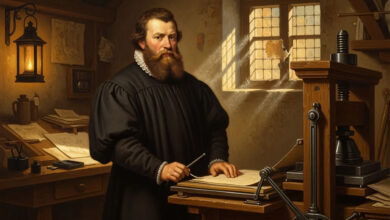Helen Adams Keller was born on 27 June 1880 in Tuscumbia, Alabama, United States. She became one of the most inspirational figures of the 20th century, overcoming the profound challenges of being both deaf and blind to become an author, political activist, and lecturer. Her story is one of extraordinary resilience, determination, and the power of education, as well as the unwavering support of those who helped her navigate the world.
Keller was born into a relatively well-off Southern family. Her father, Arthur H. Keller, was a former Confederate officer and editor of a local newspaper, while her mother, Kate Adams Keller, came from a line of prominent Southern families. Helen was a healthy baby, but at 19 months old, she was struck by an illness, likely scarlet fever or meningitis, which left her both blind and deaf. The sudden loss of two critical senses left her in a world of silence and darkness, making communication nearly impossible. Frustrated by her inability to express herself, young Helen developed a series of rudimentary signs and often resorted to tantrums out of sheer frustration.
Her parents, desperate to find a way to help their daughter, sought guidance from experts, which eventually led them to Alexander Graham Bell. Bell, known primarily for inventing the telephone, had a keen interest in working with deaf children. He referred the Kellers to the Perkins Institute for the Blind in Boston, where they found Anne Sullivan, the woman who would change Helen’s life forever. Sullivan, a visually impaired young woman who had overcome great adversity herself, arrived at the Keller household in 1887 and immediately began working with Helen, implementing a strict yet compassionate method of teaching.
The breakthrough moment came when Sullivan spelled the word “water” into Helen’s hand while pumping water over it. This realisation—that words could represent objects and concepts—was a turning point in Helen’s life. From that moment, she displayed an insatiable hunger for knowledge, quickly learning new words and grasping abstract ideas. Within months, she had mastered hundreds of words, and her ability to communicate transformed her world.
Determined to gain a formal education, Keller attended the Perkins Institute for the Blind before moving on to the Wright-Humason School for the Deaf in New York and later the Cambridge School for Young Ladies. Her academic journey culminated in 1900 when she entered Radcliffe College. With Anne Sullivan by her side, manually spelling out every lecture into her palm, Keller excelled in her studies. In 1904, she graduated with honours, becoming the first deaf-blind person to earn a Bachelor of Arts degree.
Keller’s success in education was only the beginning of her groundbreaking achievements. She became a prolific writer and speaker, advocating for the rights of people with disabilities. Her first book, “The Story of My Life,” published in 1903, provided a moving account of her early struggles and triumphs, making her an international figure of inspiration. She continued to write on a wide range of subjects, including politics, women’s rights, and social justice, demonstrating an acute awareness of the world beyond her own challenges.
Throughout her life, Keller was an outspoken advocate for various causes. She supported women’s suffrage, pacifism, and workers’ rights, often challenging societal norms and fighting against injustices. She was a staunch socialist and joined the Industrial Workers of the World, believing in the need for systemic change to uplift the working class. Her political views were sometimes met with criticism, but she remained steadfast in her beliefs.
Keller also worked tirelessly for the American Foundation for the Blind, raising awareness and funds for the education and employment of blind individuals. Her work took her around the world, where she met with world leaders, including Winston Churchill and Jawaharlal Nehru, to advocate for disability rights. She visited over 35 countries, giving lectures and inspiring countless individuals with her story of perseverance.
Her relationship with Anne Sullivan remained central to her life. Sullivan continued to be her mentor, companion, and interpreter until her death in 1936. After Sullivan’s passing, Polly Thomson, another close aide, took on the role of assisting Keller in her travels and advocacy work.
Despite the immense challenges she faced, Keller remained optimistic and believed in the power of kindness, education, and perseverance. Her famous quote, “The only thing worse than being blind is having sight but no vision,” encapsulated her belief in the importance of using one’s abilities to contribute to the greater good.
Keller continued her work well into her later years, receiving numerous accolades for her contributions. In 1964, she was awarded the Presidential Medal of Freedom by President Lyndon B. Johnson, one of the highest civilian honours in the United States. Her dedication to humanitarian efforts was recognised globally, and she remains one of the most influential disability rights activists in history.
On 1 June 1968, Helen Keller passed away in her sleep at her home in Easton, Connecticut, at the age of 87. Her funeral was attended by many who had been touched by her story, and she was laid to rest at the Washington National Cathedral in Washington, D.C.
Her legacy endures as a symbol of courage, education, and the human spirit’s ability to overcome the most daunting obstacles. The Helen Keller International organisation continues her mission, working to prevent blindness and provide aid to those with visual and hearing impairments around the world. Her story is still taught in schools, and her achievements continue to inspire people of all backgrounds and abilities. Helen Keller’s life demonstrated that disability does not mean incapacity and that barriers can be broken through determination, support, and education. More than half a century after her death, her influence remains strong, reminding the world of the boundless potential within each individual, regardless of the challenges they face.




